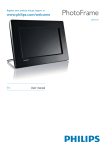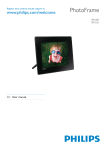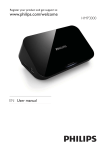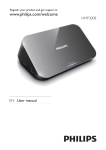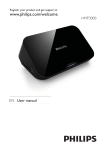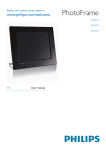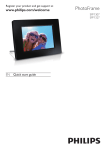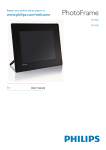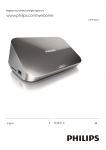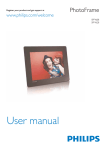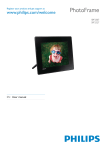Download Philips Digital PhotoFrame SPF1307
Transcript
Register your product and get support at PhotoFrame SPF1307 SPF1327 EN User manual 1 Important Safety Safety precautions and maintenance Notice Respect copyrights End of life disposal Recycling Information for Customers Environmental information North Europe Information (Nordic Countries) Banned Substance Declaration 2 Your PhotoFrame Overview of your PhotoFrame Introduction What’s in the box 3 Get started Install the stand Connect power Turn on the PhotoFrame Turn off the PhotoFrame Transfer photos 4 Display photos Manage slideshow and photos Select slideshow frequency Select slideshow sequence Rotate a photo Copy a photo Delete a photo Select a photo effect Select clock/calendar Zoom and pan a photo 5 Browse Create an album/folder Rename an album Select multiple photos 6 Clock and calendar 2 2 2 2 2 2 2 3 3 3 4 4 5 5 6 6 6 7 8 8 7 Alarm 17 8 Quick menu 18 9 Settings 19 Select an on-screen language Adjust display brightness Set time and date Set display auto on/off Hibernate the PhotoFrame Set auto orientation Set button sound Protect/Unprotect content of a memory card Set demo on/off Slideshow setting Select a slideshow transition effect Select a photo background Display collage photos View the status of the PhotoFrame Restore factory defaults Format the PhotoFrame 19 19 19 20 21 21 21 22 22 23 23 23 24 24 24 25 10 Upgrade the PhotoFrame 26 11 Product information 27 12 Frequently asked questions 29 13 Glossary 30 10 10 11 11 11 11 12 12 12 13 14 14 15 15 Need help? Please visit www.philips.com/welcome where you can access a full set of supporting materials such as user manual, the latest software updates and answers to frequently asked questions. 16 EN 1 English Contents 1 Important Safety Safety precautions and maintenance • • • • • • • • • Never touch, push, rub or strike the screen with hard objects as this may damage the screen permanently. When the product is not used for long periods, unplug it. Before you clean the screen, turn off and unplug the power cord. Only clean the screen with a soft, water-damp cloth. Never use substances such as alcohol, chemicals or household cleaners to clean the product. Never place the product near naked ames or other heat sources, including direct sunlight. Never expose the product to rain or water. Never place liquid containers, such as vases, near the product. Never drop the product. When you drop the product, it will be damaged. Ensure that you install and use services or software only from trustworthy sources free of virus or harmful software. This product is designed for indoor use only. Only use the supplied power adaptor for the product. Notice This product is in compliance with the essential requirements and other relevant provisions of Directives 2006/95/EC (Low Voltage), 2004/108/EC (EMC). 2 EN Respect copyrights The making of unauthorized copies of copyprotected material, including computer programs, les, broadcasts and sound recordings, may be an infringement of copyrights and constitute a criminal offence. This equipment should not be used for such purposes. End of life disposal • Your new product contains materials that can be recycled and reused. Specialized companies can recycle your product to increase the amount of reusable materials and to minimize the amount to be disposed of. • Please nd out about the local regulations on how to dispose your old monitor from your local Philips dealer. • (For customers in Canada and U.S.A.) Dispose the old product in accordance to local-state and federal regulations. For additional information on recycling contact www.eia.org (Consumer Education Initiative). Recycling Information for Customers Philips establishes technically and economically viable objectives to optimize the environmental performance of the organization’s product, service and activities. From the planning, design and production stages, Philips emphasizes the importance of making products that can easily be recycled. At Philips, end-of-life management primarily entails participation in national take-back initiatives and recycling programs whenever possible, preferably in cooperation with competitors. There is currently a system of recycling up and running in the European countries, such as The Netherlands, Belgium, Norway, Sweden and Denmark. Environmental information Your product is designed and manufactured with high quality materials and components, which can be recycled and reused. When you see the crossed-out wheel bin symbol attached to a product, it means the product is covered by the European Directive 2002/96/EC: North Europe Information (Nordic Countries) VARNING: FÖRSÄKRA DIG OM ATT HUVUDBRYTARE OCH UTTAG ÄR LÄTÅTKOMLIGA, NÄR DU STÄLLER DIN UTRUSTNING PÅPLATS. Placering/Ventilation ADVARSEL: SØRG VED PLACERINGEN FOR, AT NETLEDNINGENS STIK OG STIKKONTAKT ER NEMT TILGÆNGELIGE. Paikka/Ilmankierto VAROITUS: SIJOITA LAITE SITEN, ETTÄ VERKKOJOHTO VOIDAAN TARVITTAESSA HELPOSTI IRROTTAA PISTORASIASTA. Plassering/Ventilasjon ADVARSEL: NÅR DETTE UTSTYRET PLASSERES, MÅ DU PASSE PÅ AT KONTAKTENE FOR STØMTILFØRSEL ER LETTE Å NÅ. Banned Substance Declaration This product complies with RoHS. Class II equipment symbol: Never dispose of your product with other household waste. Please inform yourself about the local rules on the separate collection of electrical and electronic products. The correct disposal of your old product helps prevent potentially negative consequences on the environment and human health. This symbol indicates that this product has a double insulation system. EN 3 English In U.S.A., Philips Consumer Lifestyle North America has contributed funds for the Electronic Industries Alliance (EIA) Electronics Recycling Project and state recycling initiatives for end-of-life electronics products from household sources. In addition, the Northeast Recycling Council (NERC) - a multi-state non-prot organization focused on promoting recycling market development - plans to implement a recycling program. In Asia Pacic, Taiwan, the products can be taken back by Environment Protection Administration (EPA) to follow the IT product recycling management process, detail can be found in web site www.epa.gov.tw. 2 Your PhotoFrame Congratulations on your purchase, and welcome to Philips! To fully benet from the support that Philips offers, register your product at www.philips.com/welcome. Overview of your PhotoFrame a b c d k e f g j h i d a • • Hold to turn on/off the PhotoFrame Press to switch mode: slideshow/ clock/calendar c 4 Press to go back Hold to go to the home screen / / / • Press to select the upper/lower/right/ left option EN Press to play/pause slideshow Press to conrm a selection • Press to enter/exit a menu e b • • • • f Buzzer g Kensington lock h • SD/MMC/MS/MS Pro Slot for an SD/MMC/MS/MS Pro card Introduction j Stand hole With Philips Digital PhotoFrame, you can display JPEG photos in high quality directly from your memories cards. k Wall mounting hole What’s in the box • Philips Digital PhotoFrame • Stand • AC-DC power adaptor • CD-ROM, with digital user manual Register your product and get support at www.philips.com/welcome PhotoFrame Quick Start Guide • Quick start guide EN 5 English i DC • Socket for the AC-DC power adaptor 3 Get started Connect power Note Caution • When you position the PhotoFrame, ensure that the power plug and outlet are easily accessible. • Use the controls only as stated in this user manual. Always follow the instructions in this chapter in sequence. If you contact Philips, you will be asked for the model and serial number of this apparatus. The model number and serial number are on the back of the apparatus. Write the numbers here: Model No. __________________________ Serial No. ___________________________ 1 Connect the power cord to the DC socket of the PhotoFrame. 2 Connect the power cord to a power supply socket. Install the stand To place the PhotoFrame on a at surface, attach the supplied stand to the back of the PhotoFrame. 1 Insert the stand into the PhotoFrame. » A few seconds later, the PhotoFrame turns on automatically. 2 Screw the stand into the stand hole rmly. 6 EN • Select a language, and then press to conrm. • The screen prompts you to set time and date. • Press / / / to set time and date, and then press to conrm. English Turn on the PhotoFrame Note • When you connect the PhotoFrame to a power supply, the PhotoFrame turns on automatically. 1 When the PhotoFrame is turned off and connected to the power supply, you can hold to turn on the PhotoFrame. » A few seconds later, the home screen is displayed. For the rst time you turn on the PhotoFrame: • The screen prompts you to select a language. Tip • If the PhotoFrame is disconnected from the power supply for a long time, you need set time and date again after you turn on the PhotoFrame. EN 7 Turn off the PhotoFrame Note • You can only turn off the PhotoFrame after all copy and save actions are complete. • To turn off the PhotoFrame, press and hold for about 2 seconds. [Play Inserted Content]: Play photos on the storage device Transfer photos [Browse]: Browse photos on the storage device Caution [Transfer]: Transfer photos on the storage device to the PhotoFrame • Do not remove a storage device from the PhotoFrame when you are transferring photos from or to the storage device. 2 You can play JPEG photos on one of the following storage device that is connected to the PhotoFrame: • Secure Digital (SD) • Secure Digital High Capacity (SDHC) • Multimedia Card (MMC) • Multimedia Card Plus (MMC+) • Memory Stick (MS) • Memory Stick Pro (MS Pro, with adaptor) However, we do not guarantee the operations for all types of storage device media. 1 Insert a storage device into the slot. » An option menu is displayed. 8 EN Select [Transfer], and then press to conrm. » A conrmation message is displayed. To select all photos: 1 2 Select [Yes], and then press to conrm. Select an album on the PhotoFrame to store the photos, and then press to conrm. To select specic photos: 4 5 • Select [No], and then press to conrm. Select an album, and then press . Press / / / and then press select/deselect a photo. Press English 1 2 3 to to continue the transfer operation. Select an album on the PhotoFrame to store the photos, and then press to conrm. To remove a storage device, pull it out. EN 9 4 Display photos Manage slideshow and photos 1 You can take the following steps to manage a photo in slideshow or the settings of slideshow: In the home screen, select [Play] and then press to conrm. 1 During slideshow, press . » An option menu is displayed. 2 Select an option, and then press to conrm. • [Interval]: Select slideshow frequency • [Shufe]: Display photos randomly or not • [Rotate]: Select an angle to rotate a photo • [Copy]: Copy the photo to another album • [Delete]: Delete the photo • [Color Tone]: Select the color for the photo • [Clock and Calendar]: Select a clock/ calendar template or turn it off • [Zoom and Pan]: Press / to zoom in/out a photo To exit the menu, press again. » Photos are displayed in slideshow mode. • • During slideshow, press / to display the next/previous photo. Press to switch modes, between slideshow mode, clock mode, and calendar mode. • 10 EN Select slideshow frequency Select [Interval], and then press . Select an interval, and then press conrm. to Select slideshow sequence 1 2 Select [Shufe], and then press Select an option, and then press conrm. • • . Press / to select an orientation, and then press . Copy a photo You can display the slideshow in sequence or randomly. 1 2 Select [Rotate], and then press English 1 2 Rotate a photo Caution • Never remove a storage device before the copy or . deleting action completes. to 1 2 Select [Copy], and then press . Select a device to save the photo, and then press . [On]: To play randomly [Off]: To play in sequence EN 11 3 Select an album to save the photo, and then press . 2 Select [Yes], and then press to conrm. Select a photo effect Tip • When there is not enough memory to store more images, an error message is displayed. 1 2 Select [Color Tone], and then press Select an option, and then press . . Delete a photo Caution • Never remove a storage device before the copy or deleting action completes. 1 Select [Delete], and then press . Select clock/calendar You can select a clock or calendar to be displayed in slideshow. 1 Select [Clock and Calendar], and then press . 2 Select an option, and then press • 12 EN . To hide the clock or calendar, select [Off] and then press . Zoom and pan a photo Select [Zoom and Pan], and then press 2 Press to zoom in a photo, and then press . • Press to zoom out a photo, and then press . 3 To pan the photo, press / / / . To resume slideshow mode, press repeatedly. • . English 1 Tip • Zoom and pan function is only applied to photos over 432 x 234 pixels. EN 13 5 Browse • • • • • You can browse and manage albums and photos. 1 Select [Browse], and then press . [Move] [Delete] [Rename] [Group By] [Multiple-Select] Photo menu: 1 2 Select an album, and then press . Select a photo, and then press . » The photo menu is displayed. » The album mode is displayed. • • • • • • • [Copy] [Move] [Delete] [Rotate] [Color Tone] [Group By] [Multiple-Select] Album menu: 1 Select an album, and then press . » The album menu is displayed. Create an album/folder 1 • • 14 EN [Create New Album]: If a folder on a memory card is selected, [Create New Folder] is displayed here, instead. [Copy] Select [Create New Album] / [Create New Folder], and then press . » A keypad is displayed. 2 3 To enter the name (up to 31 characters), select an alphabet/number and then press . • To switch between uppercase and lowercase, select [a/A] on the displayed keypad and then press . To enter the name (up to 31 characters), select an alphabet/number and then press . • To switch between uppercase and lowercase, select [a/A] on the displayed keypad and then press . 3 When the name is complete, select [Enter] and then press to conrm. Select multiple photos You can select more than one photo to edit at a time. 1 Select [Multiple-Select], and then press 2 Press / / / and then deselect photos. 3 Press . » An option menus is displayed. . When the name is complete, select [Enter] and then press to conrm. Rename an album 1 Select [Rename], and then press . to select/ » A keypad is displayed. • • • • • [Copy] [Move] [Delete] [Rotate] [Play Slideshow] EN 15 English 2 6 Clock and calendar You can select a clock or calendar to be displayed in slideshow. 1 Select [Clock], and then press 2 Select [Clock] / [Calendar], and then press . • . To hide the clock or calendar, select [Off] and then press to conrm. 3 Select an option, and then press conrm. 16 EN to English 7 Alarm 1 Select [Alarm], and then press 2 Select an alarm, and then press 3 Select [Time], and then press . • To cancel the alarm, select [Off] and then press . 4 Press . • When the alarm is ringing, press any key to stop it. . . / / / to set time, and then press EN 17 8 Quick menu In the quick menu, you can adjust the brightness of the display and view the status of the PhotoFrame. 1 In the home screen, press . » The quick menu is displayed. 2 Select an option, and then press to conrm. • [Status]: To view the information of the PhotoFrame • [Brightness]: Press / to adjust the brightness, and then press . • To exit the quick menu, press 18 EN again. 2 Select [Brightness], and then press 3 Press / to adjust brightness level, and then press . . English 9 Settings Select an on-screen language 1 2 Select [Settings], and then press . Select [Languages], and then press . Set time and date 3 Select a language, and then press . 1 Select [Settings], and then press 2 Select [Time and Date], and then press . Adjust display brightness 1 Select [Settings], and then press . EN . 19 3 4 Select [Set Time] / [Set Date] / [Set Time Format] / [Set Date Format], and then press . Press / / / to set time and date or select a format, and then press . 1 Select [Settings], and then press 2 3 Select [SmartPower], and then press . 4 Select [Set on Timer] / [Set off Timer], and then press . 5 Press / / / to set time, and then press Set display auto on/off . Select [Timer], and then press . • To disable the auto on/off function, select [Off] and then press . With the SmartPower feature, you can congure the time for the PhotoFrame to turn on or off the display automatically. Note • Ensure that you set the current time and date of the PhotoFrame correctly before you set the auto on/off function. 20 EN . 1 2 3 Select [Settings], and then press Select [Settings], and then press 2 Select [Auto Orientate], and then press . 3 Select [On], and then press . • To disable the auto orientation function, select [Off] and then press . . . Select [Hibernate], and then press . Select an option, and then press . » After the selected period, the PhotoFrame hibernates. • • 1 English Hibernate the PhotoFrame To disable the hibernation function, select [Never] and then press . To get the PhotoFrame out of hibernation, hold . Set button sound 1 Select [Settings], and then press . Set auto orientation You can display photos in the correct orientation depending the horizontal/vertical orientation of the PhotoFrame. EN 21 2 Select [Set Beep], and then press 3 . Select [Disable Deleting] to disable the deleting function, and then press . • Select [Enable Deleting] to enable the deleting function, and then press . Set demo on/off 3 1 Select [Settings], and then press 2 Select [Demo], and then press 3 Select [On] to enable demo show, and then press . » When the demo mode is ON, the PhotoFrame plays the demo slideshow automatically once the power cable is connected to the power supply. • To disable demo show at power up, select [Off] and then press . . Select [On] to turn on the button sound, and then press . • To turn off the button sound, select [Off] and then press . Protect/Unprotect content of a memory card . You can enable the deleting function on a storage device available on the PhotoFrame. To avoid deleting photos on a storage device, you can also disable the deleting function on a storage device. 1 Select [Settings], and then press . 2 Select [Memory Card], and then press 22 EN . 3 Select [Background Color], and then press 4 Select an option, and then press . » If you select a background color, the PhotoFrame displays a photo with a background color. . English Slideshow setting Select a slideshow transition effect 1 2 3 4 Select [Settings], and then press . Select [Slideshow], and then press . Select [Transition Effect], and then press . » If you select [Auto Fit], the PhotoFrame extends a photo to ll the screen with picture distortion. Select an option, and then press . Select a photo background 1 2 Select [Settings], and then press . » If you select [RadiantColor], the PhotoFrame extends the color on the edges of a photo that is smaller than the full screen to ll the screen without black bars or aspect ratio distortion. Select [Slideshow], and then press . EN 23 View the status of the PhotoFrame 1 Select [Settings], and then press 2 Select [Info]. . Display collage photos 1 2 3 Select [Settings], and then press . Select [Slideshow], and then press Select [Collage], and then press . . » The information of the PhotoFrame is displayed on the right of the screen: internal memory, used memory, free space, and the software version. Restore factory defaults 4 24 1 Select [Settings], and then press 2 Select [Reset], and then press . Select a collage option, and then press . • To disable the collage function, select [Single] and then press . EN . Select [Yes], and then press . 2 Select [Format], and then press 3 Select [Yes], and then press . English 3 » A conrmation message is displayed. 4 Select [Yes], and then press . . Format the PhotoFrame Caution • All photos on the PhotoFrame will be lost after you format the PhotoFrame. 1 Select [Settings], and then press . EN 25 10 Upgrade the PhotoFrame Caution • Do not power off the PhotoFrame during upgrade. If there is a software update, you can download the latest software from www.philips.com/ support to upgrade your PhotoFrame. The earlier software is unavailable on line. 1 2 Visit www.philips.com/support. Search for your PhotoFrame and go to the software section. 3 Download the latest software onto the root directory of an SD card. 4 5 Insert the SD card into the PhotoFrame. Turn on the PhotoFrame » A conrmation message is displayed. 6 Select [Yes], and then press to conrm. » When the upgrade is complete, the PhotoFrame reboots. 26 EN Note • Product information is subject to change without prior • • Input: AC 100-240V~50-60Hz 0.3A Output: DC 9V 1.1A Adaptor Region SSW-1918EU Europe, Russia, and Singapore SSW-1918UK U.K. and Hong Kong SSW-1918AU Australia and New Zealand SSW-1918CN China notice. Picture/Display • Viewing angle: @ C/R > 10, 120° (H)/100° (V) • Lifetime, to 50% brightness: 20000 hr • Aspect ratio: 16:10 • Panel visible resolution: 432 x 234 • Best-t photo resolution: 440 x 270 • Brightness (minimum): 160 cd/m² • Contrast ratio (typical): 300:1 Storage media • Memory card types: • Secure Digital (SD) • Secure Digital (SDHC) • Multimedia Card (MMC) • MMC plus (MMC+) • Memory Stick (MS) • Memory Stick Pro (MS Pro) • Built-in memory capacity: 128 MB Dimensions & Weight • Set dimensions without stand (W x H x D): 206 x 139 x 25 mm • Set dimensions with stand (W x H x D): 206 x 139 x 104 mm • Weight without stand: 0.334 kg Power • Power mode supported: AC powered • Efciency level: V • Average consumption (system on): 3.65 W • Power adaptor: • Manufacturer: Philips Consumer Lifestyle International B.V. • Model number: SSW-1918xx-y (xx=EU, UK, AU, BR; Y=1, 3) English 11 Product information Temperature • Operation: 0°C - 40°C/32°F - 104°F • Storage: -10°C - 60°C/14°F - 140°F Accessories • AC-DC power adaptor • Stand • CD-ROM, with digital user manual • Quick start guide Convenience • Card Reader: Built-in • Photo format supported: • JPEG photo (Up to 10MB JPEG les, Up to 64 Megapixels) • Progressive JPEG photo (Up to 1024 x 768 pixels) • Placement supported: Photo auto orientation, Landscape, Portrait • Buttons and controls: 3 buttons, 4-way navigation key and enter • Playback mode: Slideshow, clock, calendar • Photo edit: Copy, delete, rotate, photo effect, zoom and pan • Slideshow setting: Slideshow sequence, transition effect, frequency, collage, background color • Screen background: Black, white, gray, auto t, RadiantColor • Setup function: Brightness adjustment, language, information, beep on/off, set time and date, SmartPower • System status: Internal memory, used memory, free space, and the rmware version EN 27 • • • 28 Regulatory Approvals: BSMI, C-Tick, CCC, CE, GOST, PSB Other convenience: Kensington lock compatible On-Screen Display languages: English, Danish, Dutch, French, German, Italian, Portuguese, Russian, Simplied Chinese, Spanish, Traditional Chinese EN Is the LCD screen touch-enabled? The LCD screen is not touch-enabled. Use the buttons on the back to control the PhotoFrame. Can I switch different slideshow photos by using different memory cards? Yes. When a memory card is connected to the PhotoFrame, you can play photos on the specic memory card in slideshow mode. Will the LCD be damaged, if I keep showing the same photo for a long time? No. The PhotoFrame can display the same photo continuously for 72 hours without any damage to the LCD screen. Why does my PhotoFrame not show some of my photos? The PhotoFrame supports only JPEG photos. Ensure that these JPEG photos are not damaged. Can I use the PhotoFrame during its display auto-off periods? Yes. You can press to wake up the PhotoFrame. Why does the PhotoFrame not go into autooff status after I set it? Ensure that you set the current time, autooff time, and auto-on time correctly. The PhotoFrame automatically turns off its display exactly at the auto-off time. If the time has already passed for the day, it starts to enter auto-off status at the specied time from the next day. Can I increase the memory size to store more pictures on the PhotoFrame? No. The internal memory of the PhotoFrame is xed and cannot be expanded. However, you could switch between different photos by using different storage devices on the PhotoFrame. After I insert a memory card and transfer all content to the PhotoFrame, I nd that the folder structure saved on the PhotoFrame is different from the original structure on the memory card. Why? The PhotoFrame can only read a folder structure up to 3 levels and write on only 1-level folder structure. In that case, photos on a memory card, which are in folders with the same name but in different levels, will be saved in the same folder on the PhotoFrame. For example, photos in folders “\AA”, “\01\ AA” and “\02\AA” on a memory card will all be copied into the folder named “\AA” on the PhotoFrame. What is the best resolution of photos to be displayed on the PhotoFrame? The best resolution is 440 x 270, 880 x 540, or a similar aspect ratio. Why does the PhotoFrame automatically turn off? If you enable the hibernate function or SmartPower function, the PhotoFrame automatically turns off at the preset time. For details, see sections “Hibernate the PhotoFrame” and “Set display auto on/off ”. EN 29 English 12 Frequently asked questions 13 Glossary A Aspect ratio Aspect ratio refers to the length to height ratio of TV screens. The ratio of a standard TV is 4:3, while the ratio of a high-denition or wide TV is 16:9. The letter box allows you to enjoy a picture with a wider perspective on a standard 4:3 screen. J JPEG A very common digital still picture format. A still-picture data compression system proposed by the Joint Photographic Expert Group, which features small decrease in image quality in spite of its high compression ratio. Files are recognized by their le extension ‘.jpg’ or ‘.jpeg.’ K Kbps Kilobits per second. A digital-data-rate measurement system which is often used with highly compressed formats such as AAC, DAB, MP3 etc. The higher the amount, the better the quality generally is. Kensington lock A Kensington Security Slot (also called a K-Slot or Kensington lock). Part of an anti-theft system. It is a small, metal-reinforced hole found on almost all small or portable computer and electronics equipment, particularly on expensive and/or relatively light ones, such as laptops, computer monitors, desktop computers, gaming consoles, and video projectors. It is used for attaching a lock-and-cable apparatus, in particular those from Kensington. 30 EN M Memory Stick Memory Stick. A ash memory card for digital storage on cameras, camcorders and other handheld devices. MMC Card MultiMedia Card. A ash memory card that provides storage for cellphones, PDAs and other handheld devices. The card uses ash memory for read/write applications or ROM chips (ROM-MMC) for static information, the latter widely used for adding applications to a Palm PDA. S SD Card Secure Digital Memory Card. A ash memory card that provides storage for digital cameras, cellphones and PDAs. SD Cards use the same 32 x 24mm form factor as the MultiMediaCard (MMC), but are slightly thicker (2.1mm vs. 1.4mm), and SD Card readers accept both formats. Cards up to 4GB are available. T Thumbnail A thumbnail is reduced-size versions of a picture that is used to make it easier to recognize an them. Thumbnails serve the same role for images as a normal text index does for words. © 2010 Koninklijke Philips Electronics N.V. All rights reserved. UM_V1.1G 12NC

































